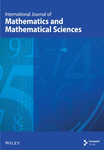On Restricted Detour Median of Special Graphs
Abstract
The restricted detour distance between two vertices is the length of longest path P such that the induced subgraph for a vertex set of P is identical P. The number of restricted detour distance of a vertex v of a connected graph Ǥ is a summation of restricted detour distances from v to all vertices of Ǥ. In this paper, we give a new definitions called restricted detour median graph (RDM-graph) and restricted detour self-median graph (RDSM-graph) and then we find many results related with them.
1. Introduction
There are many types of distance in a simple connected graph Ǥ in graph theory [1, 2], some of them depend on distance between two vertices from the set vertex of Ǥ, V(Ǥ), such as ordinary distance [3], detour distance and restricted detour distance [4, 5], and Steiner distance [6], while others depend on two subsets of V(Ǥ), such as maximum (or average or minimum) distance between two subsets of V(Ǥ) [7], sometimes depends on one vertex and a subset of V(Ǥ) such as min −k−distance and max −k−distance, where k does not exceed the number of vertices of the graph [8], in addition to the presence of a invariant number that depends on degrees [9] only or depends on the ordinary distance and degrees [10, 11]. The reason for the diversity of finding definitions of distance in graph theory is because of its very great importance of applications, such as geometric communications [12], computer science [13], and chemistry science [14]. For any two vertices, u and v, the shortest path is the ordinary distance, denoted by d(u, v). The longest path between two distinct vertices, u and v, is the detour distance, dD(u, v), but the restricted detour distance is the longest path P that connected two vertices u and v such that <V(P) > = P, where <V(P)> reference to a subgraph of Ǥ that is induced by V(P) where V(P) is its vertex set; furthermore, if an edge of Ǥ connects two vertices of V(P), then it is an edge of <V(P)> [15]. The topics of detour distance and restricted detour distance have been the subject of numerous recent studies; you can see them in references [16–18]. Therefore, our aim in this paper is to present a new concept related with restricted detour number.
Definition 1. For any connected graph Ǥ, the restricted detour distance [4] of the vertex v ∈ V(Ǥ) is
Definition 2. The restricted detour median graph (RDM-graph) for all connected graph Ǥ is a subgraph M∗(Ǥ) of a graph Ǥ that is induced from those vertices which have minimum number of restricted detour distance.
The importance of RDM-graph is that we can obtain a new chemical compound from a given chemical compound that is more stable and clearer in terms of some of the chemical properties of the chemical compounds, for example, boiling point or melting point.
It is unknown whether for every a connected graph Ǥ, there exists a graph H such that M∗(H) = Ǥ. For any connected graph Ǥ and every vertex u that does not belong to the set of vertex of Ǥ, we note that , ∀ v ∈ V(Ǥ), where Ǥ′ is got from Ǥ by joining u to at last one vertex of Ǥ. To illustrate this, we provide the next example.
Example 1. Consider a graph Ǥ that appears in Figure 1.
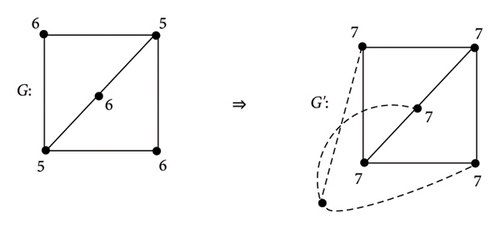
Definition 3. For any connected graph Ǥ, if M∗(Ǥ) = Ǥ, then Ǥ is called a restricted detour self-median graph (RDSM-graph).
Example 2. The graphs Cp, Kᶆ,ᶆ, and Kp are RDSM-graphs, p, ᶆ ≥ 3.
It is very difficult to find graph H such that M∗(H) = H⊃Ǥ.
Definition 4. The graph which has p of vertices and without edges is called an empty graph, which is denoted as Ep [2].
Definition 5. Let Ǥ be a simple connected graph of order p which has the vertex set V(Ǥ) = {u1, u2, …, up} and T = {t1, t2, …, tp} be an n-tuple of nonnegative integers. The thorn graph is a graph generated by joining ti vertices of degree one to the vertex ui ∈ V(Ǥ), i = 1, 2, …, p [19].
2. RDM-Graph Containing Some Special Graphs
In this section, we find RDM-graph for some special graphs, such as complete bipartite, path, and cycle graphs.
2.1. Complete Bipartite Graph
If Ǥ ≡ Kᶆ,ᶇ, ᶆ, ᶇ ≥ 2 and ᶆ ≠ ᶇ, say ᶆ > ᶇ, then there is graph H ≡ Kᶆ,ᶆ, which is a RDM-graph containing induced subgraph Kᶆ,ᶇ, that is, M∗(Kᶆ,ᶆ)⊃Kᶆ,ᶇ, see Figure 2.
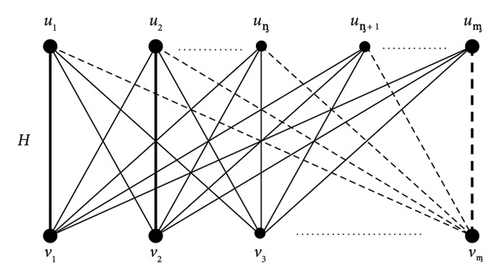
Moreover, for , |ᶇi| = ᶇ, i = 1, 2, …, t, we have , for each v in V(Kᶇ(t)); thus, Kᶇ(t) isa RDM-graph for itself. Consider Kᶆ,ᶇ,t, with ᶆ, ᶇ, t not equal integers without loss of generality, and we assume ᶆ > ᶇ ≥ t. One may check that Kᶆ,ᶇ,t is an induced subgraph of Kᶆ,ᶆ,ᶆ, which is a restricted detour median itself. Thus, in general, is an induced subgraph of self-RDM-graph Kᶇ(t), where ᶇ = max{ᶇ1, ᶇ2, ᶇ3, …, ᶇt}.
Proposition 1. If the empty graph Ǥ of order ᶇ has a vertex set {u1, u2, …, uᶇ}, ᶇ > 1, then Ǥ is a RDM-graph of a graph Kᶆ,ᶇ, for ᶆ > ᶇ.
Proof 1. In Kᶆ,ᶇ, we have
2.2. Path Graph
We shall give some examples for special path graphs Pp such that there exits a graph H, with a path Pp as an induced subgraph of H, and M∗(H) = Pp for some p.
- 1.
If Ǥ = P2, then H2 is a graph as illustrated in Figure 4.
(4) - 2.
If Ǥ = P3 : u1, u2, u3, one may easily check that restricted detour distance for each vertex of H3 in Figure 5 shown in the following.
-
Thus, M∗(H3) = P3.
- 3.
If Ǥ = P4 : u1, u2, u3, u4, then H4 is shown in Figure 6, and the depicted graph satisfies M∗(H4) = P4.
- 4.
If Ǥ = P5 : u1, u2, u3, u4, u5, then M∗(H5) = P5, where H5 is illustrated in Figure 7.
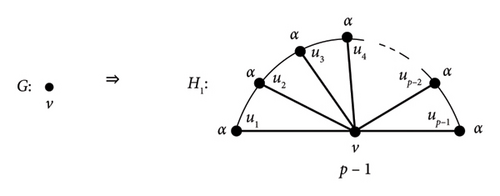
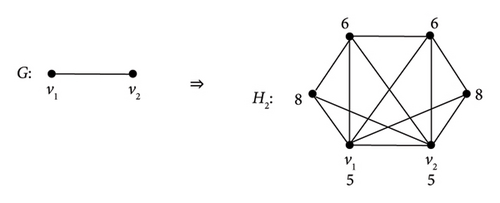
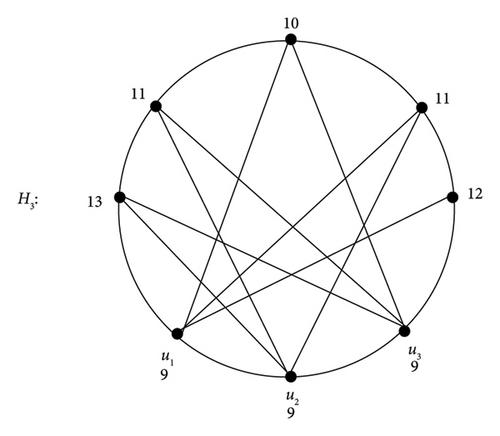
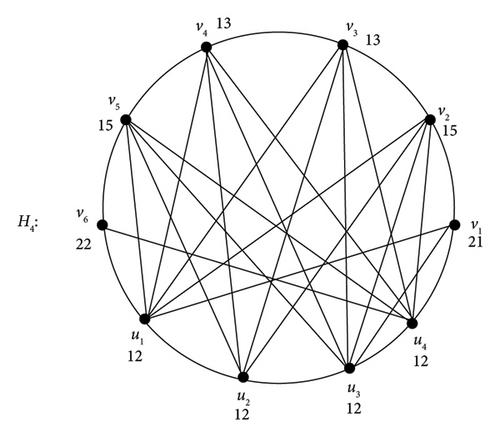

Finally, we think that, there exists a graph H for every path Pp, p ≥ 6, containing Pp as induced subgraph such that M∗(H) = Pp.
Problem 1. How to describe the construction of such H?
2.3. Cycle Graph
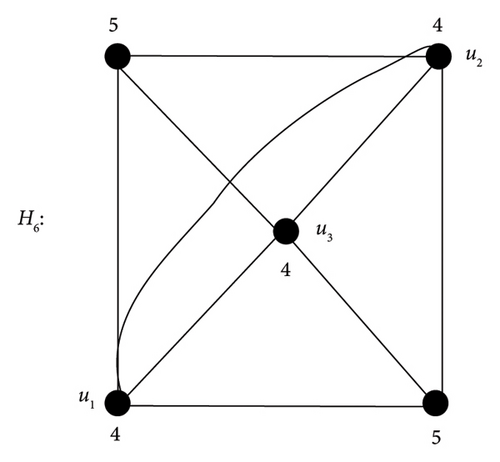
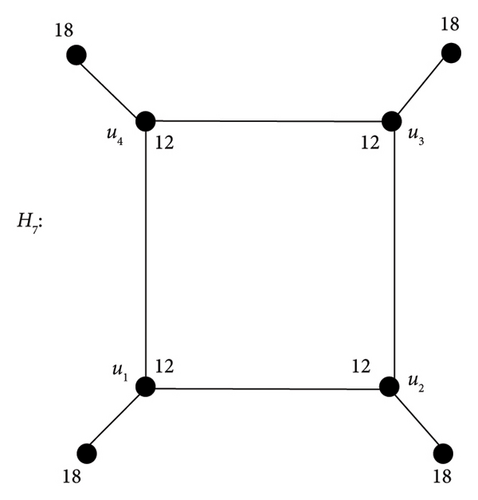
Theorem 1. For any cycle Cp:u1, u2, u3, …,up, u1, p ≥ 4, there exists a graph H in which Cp is an induced subgraph of H and M∗(H) = Cp.
Proof 2 (see Figure 10.)The following cases is clear for i = 1, 2, 3, …, p.
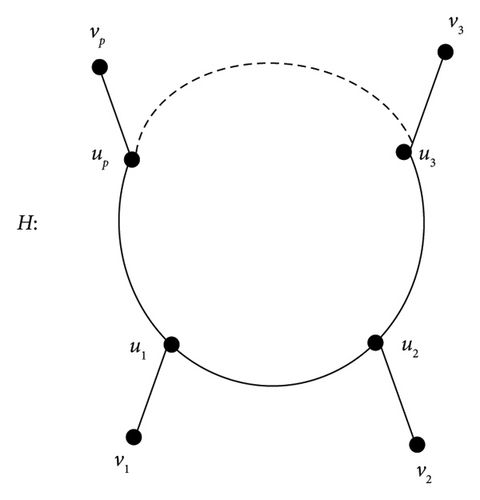
Case 1. If p is even, then
Hence, M∗(H) = Cp = <{u1, u2, u3, …,up}>.
Case 2. If p is odd, then
Hence, M∗(H) = Cp = <{u1, u2, u3, …,up}>.
From (5) (or (7)) and (6) (or (8)), we note that .
Proposition 2. For all connected graph Ǥ of order p, p ≤ 3, there exists a graph Hi in which M∗(Hi) = Ǥ and Ǥ is an induced subgraph of Hi, where i = 1, 2, 3, 4.
Proof 3. For p = 1, we have H1 = P3.
For p = 2, we have H2 = P4.
For p = 3, we have H3 and H4 as shown in Figure 11.
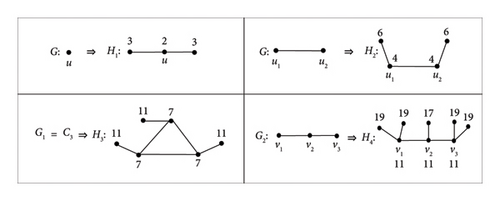
Hence, the proof is complete.
Proposition 3. For any connected graph Ǥi which has the order p = 4, Ǥi ≠ S4 (star graph of order 4), there exists a graph Hi such that Ǥi is an induced subgraph of Hi and M∗(Hi) = Hi, where i = 1, 2, 3, 4, 5.
Proof 4. For p = 4, the corresponding Hi such that M∗(Hi) = Ǥi, i = 1, 2, 3, 4, 5 is shown in Figure 12.
Hence, the proof is complete.
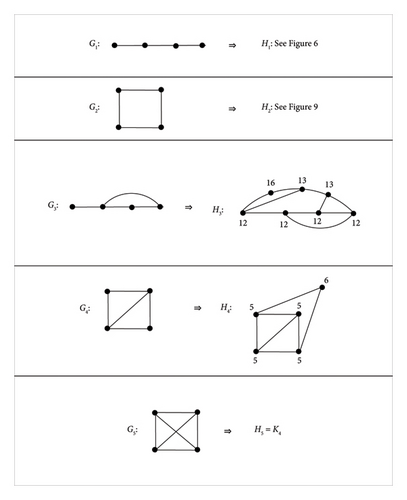
3. RDSM-Graph Containing Some Special Graphs
Proposition 4. Suppose that Ǥ is a RDSM-graph with |V(Ǥ)| = p and V(Ǥ) = {u1, u2, …, up} Then, there exists a graph H of order 2p constructed from Ǥ by adding vertices v1, v2, …, vp with edges {viui:i = 1, 2, …, p}, and Ǥ is the induced subgraph of H and M∗(H) = Ǥ.
Proof 5. From Figure 13(a), one may easily notice that for all i = 1, 2, …, p, and , in which .
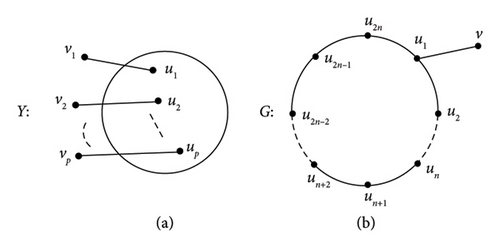
Thus, Ǥ is the detour median of H, and Ǥ is the induced subgraph of H.
The special graphs Kp, Kᶆ,ᶆ, and Cp are the graphs satisfying the property mentioned in Proposition 4, M∗(H) = Ǥ.
Proposition 5. If Ǥ is an RDSM-graph of order p, p ≥ 3, then Ǥ contains no end-vertex.
Proof 6. If v is a vertex has degree one, and u is the unique vertex adjacent to v, then
Thus, v ∉ M∗(Ǥ) contradicting M∗(Ǥ) = Ǥ.
Proposition 6. Suppose that Ǥ is a connected RDSM-graph where |V(Ǥ)| = p, p > 4, and v is an end-vertex of G, then v ∉ M∗(Ǥ).
Proof 7. By contradiction (see Figure 13).
Let u be the vertex adjacent to v in Ǥ, and let Ǥ′ = Ǥ − v.
Thus, .
Therefore, .
By the definition of the median vertex, v ∉ M∗(Ǥ).
Corollary 1. If u is a median vertex in Ǥ, then u is the only median vertex in Y.
Proof 8. Let w ∈ V(Ǥ′), then from Figure 13, we obtain
If u ∈ M∗(Ǥ′), then .
From (10), we have .
From (11), we have .
Hence, if w ≠ u, then , which implies that u is the only median vertex in Y.
To explain the previous propositions, we take the following examples:
Example 3. Let C2ᶇ : u1, u2, … , u2ᶇ−1, u2ᶇ, u1, ᶇ ∈ N − {1} and v is an isolated vertex, then the graph Ǥ is constructed from C2ᶇ with edge vu1.
Example 4. Let C2ᶇ+1 : u1, u2, … , u2ᶇ−1, u2ᶇ, u2ᶇ+1, u1, ᶇ ∈ N − {1}, and v is an isolated vertex, then the graph Ǥ constructed from C2ᶇ+1 with edge vu1.
Hence, , j > 1.
To illustrate the above two examples in Figure 14, we take the cycle graph Cp of different orders.
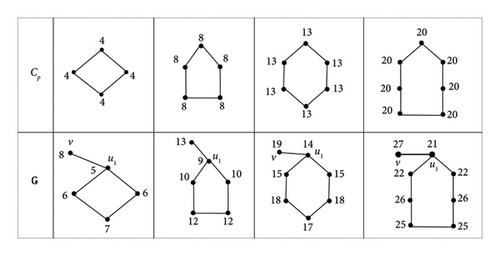
Example 5.
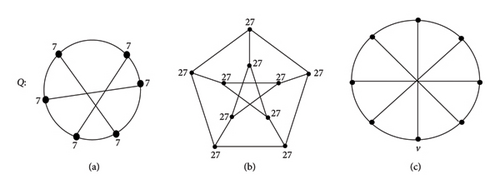
- 3.
For empty graph Ep of order p, we have Kp,p+1
- 4.
For the graph even order p with exactly p/2 nonadjacent edge v1v2, v3v4, …, vp−1vp, p ≥ 4. We have graph which is illustrated in Figure 17.

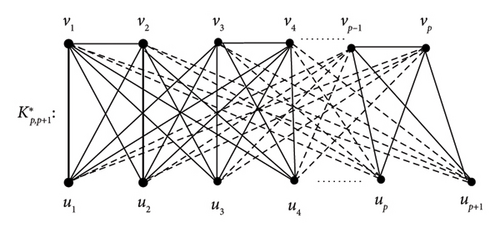
Remark 1. For disconnected graph Ǥ″ of order 3 and an edge v1v2, we have a graph H″ as shown in Figure 18; it is clear that Ǥ″ is an induced subgraph of H″ and M∗(H″) = Ǥ″ because d∗(vi) = 7, d∗(u1) = 9 for i = 1, 2, 3 and d∗(u4) = 8
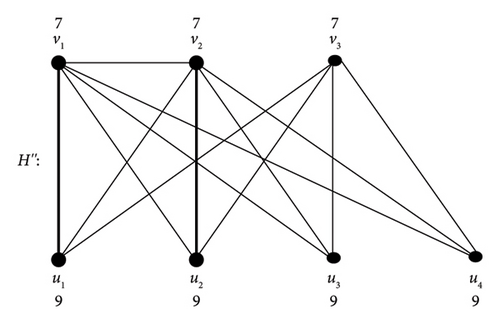
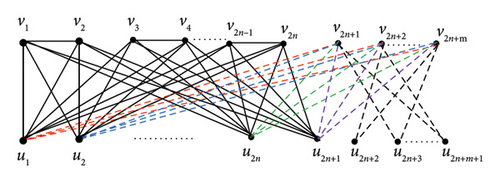
Therefore, Ǥ is an induced subgraph of H and M∗(H∗) = Ǥ.
4. Conclusions
In this article, a new definition “RDM-graph” was presented, which through it is possible to obtain new graphs that is more relevant and consistent, which allows us to find new properties that can be described as an application for some chemical compounds that need bonding between their atoms in order to be more stable.
Conflicts of Interest
The authors declare no conflicts of interest.
Author Contributions
All the authors have equally contributed to the final manuscript.
Funding
No funding was received for this paper.
Acknowledgments
This paper was conducted at the College of Computer Science and Mathematics, University of Mosul, Iraq, and the General Directorate of Education in Nineveh, Iraqi Ministry of Education-Mosul, Iraq.
Open Research
Data Availability Statement
The information and data used in this research are theoretical and not derived from any other research or institution.



